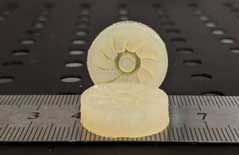
Virginia Tech researchers, in a joint collaboration with Michelin North America via a National Science Foundation award, have discovered a novel process to 3D print latex rubber. This opens up the printing of a variety of elastic materials with complex geometric shapes.
Latex, commonly used for gloves, refers to a group of polymers, long, repeating chains of molecules, coiled inside nanoparticles dispersed in water. 3D printed latex and other similarly rubbery materials called elastomers could be used for a variety of applications, including soft robotics, medical devices, or shock absorbers.
3D printed latex has been documented only a handful of times in scientific literature. None of the previous examples come close to the mechanical properties of the latex printed by an interdisciplinary team affiliated with the Macromolecules Innovation Institute (MII), the College of Science, and the College of Engineering.
Through novel innovations in both the chemistry and mechanical engineering disciplines, the team overcame some long-standing limitations of 3D printing, also known as additive manufacturing. The researchers chemically modified liquid latexes to make them printable and built a custom 3D printer with an embedded computer vision system to print accurate, high-resolution features of this high-performance material.
“This project represents the quintessential example of interdisciplinary research,” said Timothy Long, a professor of chemistry and a co-principal investigator on this project along with Christopher Williams, the L.S. Randolph Professor of mechanical engineering and interim director of MII. “Neither of our labs would be able to accomplish this without the other.”
Details of their initial results are detailed in a journal article published in ACS Applied Materials & Interfaces.
After unsuccessful attempts to synthesise a material that would provide the ideal molecular weight and mechanical properties, Phil Scott, a fifth-year macromolecular science and engineering student in the Long Research Group, turned to commercial liquid latexes.
The researchers ultimately wanted this material in a solid 3D printed form, but Scott first needed to augment the chemical composition to allow it to print.
Scott ran into a fundamental challenge: liquid latex is extremely fragile and difficult for chemists to alter.
“Latexes are in a state of Zen,” said Viswanath Meenakshisundaram, a fifth-year mechanical engineering Ph.D. student in the Design, Research, and Education for Additive Manufacturing Systems Lab who collaborated with Scott. “If you add anything to it, it’ll completely lose its stability and crash out.”
Then, the chemists built a scaffold, similar to those used in building construction, around the latex particles to hold them in place. This way, the latex could maintain its great structure, and Scott could add photoinitiators and other compounds to the latex to enable 3D printing with ultraviolet (UV) light.
While Scott tinkered with the liquid latex, Meenakshisundaram had to figure out how to correctly print the resin. The researchers chose to use a process called vat photopolymerisation, in which the printer uses UV light to cure, or harden, a viscous resin into a specific shape.
Needing a printer capable of printing high-resolution features across a large area, Meenakshisundaram built a new printer. He and Williams, his advisor, came up with the idea to scan the UV light across a large area, and in 2017, they filed a patent for the printer.
Even with the custom printer, the fluid latex particles caused scattering outside of the projected UV light on the latex resin surface, which resulted in printing inaccurate parts, so Meenakshisundaram devised a second novel idea. He embedded a camera onto the printer to capture an image of each vat of latex resin. With his custom algorithm, the machine is able to “see” the UV light’s interaction on the resin surface and then automatically adjust the printing parameters to correct for the resin scattering to cure just the intended shape.
Meenakshisundaram and Scott discovered their final 3D printed latex parts exhibited strong mechanical properties in a matrix known as a semi-interpenetrating polymer network, which hadn’t been documented for elastomeric latexes in the prior literature.
Long and Williams said 3D printed latex provides the conceptual framework for printing a range of unprecedented materials from rigid plastics to soft rubbers, which have been unprintable until now.
